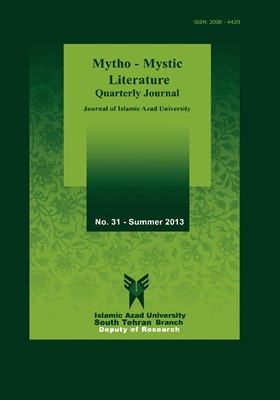The Psychoanalysis of Characters and Mystical Symbols in the Story of Romiyan–o-Chiniyan of Masnavi Manavi
Subject Areas : MythoParvin Golizādeh 1 , Nasrin Gobānchi 2
1 - Associate professor of Persian language and Literature, University of Shahid Chamran
2 - M.A. Candidate of Persian Language and Literature, University of Shahid Chamran
Keywords: Molana, mystical symbols, Psychoanalysis of Personality, the Story Romiyan–o-Chiniyan of Maanavi Masnavi,
Abstract :
The way symbols and characters- as the two important elements of a story- are presented in Masnavi Manavi, comes from Molana’s viewpoints about human. This study intends to investigate some of the mystical and hidden aspects of Masnavi Manavi based on psychological and mythical concepts. Therefore a number of the narrative elements of the story of Romiyan–o–Chiniyan (Romans and Chinese) are studied here regarding psychological concepts provided by psychologists like Jung, Murray, Freud and Adler. Some of these concepts are analyzed in relation to mystical and mythical elements. In this story, Yung theories about characterization, collective beliefs, and archetypes are more visible than the theories of Fraud and Adler.
کتابنامه
اتونی، بهروز. 1391. «دبستان نقد اسطورهشناختی ژرفا بر بنیاد کهننمونه نرینهروان (آنیموس)»، فصلنامه ادبیات عرفانی و اسطورهشناختی دانشگاه آزاد اسلامی واحد تهران جنوب، س هشتم. ش 28.
احمدی، بابک. 1370. ساختار و تأویل متن. چاپ اوّل. تهران: مرکز.
پورنامداریان، تقی. 1383. رمز و داستانهای رمزی در ادب فارسی. چاپ پنجم. تهران: علمی و فرهنگی.
زرینکوب، عبدالحسین. 1382. نردبان شکسته. تهران: سخن.
زمانی، کریم. 1382. میناگر عشق. تهران: نی.
ستاری، جلال. 1366. «سه مفهوم اساسی در روانشناسی یونگ»، در رمز و مثل در روانکاوی. زیر نظر و ترجمه جلال ستاری. تهران: توس. صص474-431.
سجادی، سیدجعفر. 1362. فرهنگ لغات و اصطلاحات و تعبیرات عرفانی. چاپ سوم. تهران: طهوری.
سیاسی، علی اکبر. 1386. نظریههای شخصیت یا مکاتب روانشناسی. چاپ یازدهم. تهران: دانشگاه تهران.
شولتز، دوان. پی و سیدنی الن شولتز. 1389. نظریههای شخصیت. ترجمه یحیی سید محمدی. چاپ هفدهم. تهران: ویرایش.
کازنوو، ژان. 1377. «اسطوره شناسی»، در جهان اسطورهشناسی. زیر نظر و ترجمه جلال ستاری. ج1. تهران: مرکز. صص202 - 173.
محمدی، علی و مریم اسمعاعیلپور. 1391. «بررسی تطبیقی کهنالگوی نقاب در آراء یونگ و ردپای آن در غزلهای مولانا (غزلیات شمس)»، فصلنامه ادبیات عرفانی و اسطورهشناختی دانشگاه آزاد اسلامی واحد تهران جنوب، س هشتم. ش 28.
مدرس مطلق، سیدمحمدعلی. 1379. رساله در وحدت وجود. تهران: پرسش.
مورنو، آنتونیو. 1388. یونگ، خدایان و انسان مدرن. ترجمه داریوش مهرجویی. چاپ پنجم 5. تهران: مرکز.
مولوی، جلالالدین محمد. 1383. مثنوی معنوی. تصحیح رینولد نیکلسون. چاپ ششم. تهران: ققنوس.
مؤمنزاده، محمدصادق. 1378. برداشتهای روان درمانی از مثنوی. تهران: سروش.
وزینپور، نادر. 1365. آفتاب معنوی. تهران: امیرکبیر.
هاشمی، جمال. 1379. پیغام سروش (مکتبهای مولانا و روانشناسی نوین). تهران: شرکت سهامی انتشار.
یونگ، کارل گوستاو. 1359. انسان و سمبولهایش. ترجمه ابوطالب صارمی. چاپ دوم. تهران: کتاب پایا.
ــــــــــــــــــــــــ . 1386. انسان و سمبولهایش. ترجمه محمود سلطانیه. چاپ ششم. تهران: جامی.
ــــــــــــــــــــــــ . 1372. روانشناسی ضمیر ناخودآگاه. ترجمه محمدعلی امیری. تهران: انتشارات و آموزش انقلاب اسلامی.
_||_
References
Ahmadi, Bābak. (1991/1370SH). Sākhtār o ta'vil-e matn. 1st ed. Tehran: Markaz.
Atouni, Behrouz. (2012/1391SH). “dabestān-e naqd-e ostoure-shnākhti-e zharfā bar bonyād-e kohan-nemoune-ye narine-ravān (Animus), Azad university quarterly journal of Mytho-mystic literature, No 28.
Cazeneuve, Jean. (1998/1377SH). “Ostoure shenāsi” (“Les mythologies à travers le monde”). In Jahān-e ostoure-shenāsi (The World of Mithology). Tr. By Jalāl Sattāri. Vol. 1. 1st ed. Tehran: Markaz. Pp. 173-202.
Duane P. Schultz, Sydney Ellen Schultz. (2010/ 1389SH). Nazarye-hā-ye shakhsiat (Theories ofPersonality). Tr. By Yahyā Seyed Mohammadi. 17th ed. Tehran: Virāyesh.
Hāshemi, Jamāl. (2000/1379SH). Peyghām-e sorpush (Maktab-hā-ye Mowlānā o ravānshenāsi-e novin). 1st ed. Tehran: Sherkat-e sahāmi-e enteshār.
Jung, Carl Gustav. (1980/1359SH). Ensān o Sambol-hā-yash (The Man and his symbols).Tr.By Aboutāleb Sāremi. 2nd ed. Tehran : Ketāb-e Pāyā
----------------------. (1991/1370SH).Ravānshnāsi o din (Psychology and religion: west and East). Tr. By M. Hosein Sorouri. 1st ed. Tehran: Sokhan.
----------------------.(1993/1372SH). Ravānshenāsi-e zamir-e nākhodāgāh (Uber die psychologie des unbewussten). Tr. By Mohammad 'Ali Amiri. Tehran: Enteshārāt o āmouzesh-e enqelāb-e eslāmi.
Modare Motlaq, S. Mohammad 'Ali. (2000/1379SH). Resāle dar vahdat-e vojoud. 1st ed. Tehran: Parastesh.
Mohammadi, 'Ali and Maryam Esmā'eilpour. (2012/1391SH). “Barresi-e tatbiqi-e kohan-olgou-ye neqāb dar ārāy-e Young o radd-e pā-ye ān dar ghazal-hā-ye Mowlānā”, Azad University Quarterly Journal of Mytho-Mystic Literature, No. 28.
Mo'menzādeh, M. Sādeq. (1999/1378SH). Bardāsht-hā-ye ravāndarmāni az Masnavi. 1st ed. Tehran: Soroush.
Moreno, Antonio. (2009/ 1388SH). Young, khodāyān o ensān-e modern (Jung, gods and modern man). Tr. By Dārioush Mehrjouei. 5th ed. Tehran: Markaz.
Mowlavi, Jalāl-oddin Mohammad. (2004/1383SH). Masnavi-e Ma'navi. Ed. By R.N. Nicolson. 6th ed. Tehran: Qoqnous.
Pournamdāriān, Taghi (2004/1383SH). Ramz va dāstān-hā-ye ramzi dar adab-e Fārsi. 3nd ed. Tehran: 'Elmi va farhangi.
Sajjādi, S. Ja'far. (1983/1362SH). Farhang-e loghāt o estelā'hāt o ta'birāt-e 'erfāni. 3rd ed. Tehran: Tahouri.
Sattāri Jalāl. (1987/1366SH). “Se mafhoum-e asāsi dar ravānshenāsi-e Young”, In Ramz o masal dar ravānkāvi (Symbol and Allegory in psychoanalysis). Tr. By Jalāl Sattāri. 1st ed. Tehran: Tous. Pp. 431-474.
Siāsi, 'Ali Akbar. (2007/1386SH). Nazarye-hā-ye shakhsiat yā makāteb-e ravanshenāsi. 11th ed. Tehran: University of Tehran.
Tāj-oddini, 'Ali. (2004/1383SH). Farhang-e namād-hā o neshāne-hā dar andishe-ye Mowlānā. 2nd ed. Tehran: Soroush.
Vazinpour, Nāder. (1986/1365SH). Āftāb-e ma'navi. 1st ed. Tehran: Amirkabir.
Zamāni, Karim. (2003/1382SH). Mināgar-e 'eshq. 1st ed. Tehran: Ney.
Zarrinkoub, Abd-olhosein. (2003/1382SH). Nardebān-e Shekaste. 1st ed. Tehran: Sokhan.

